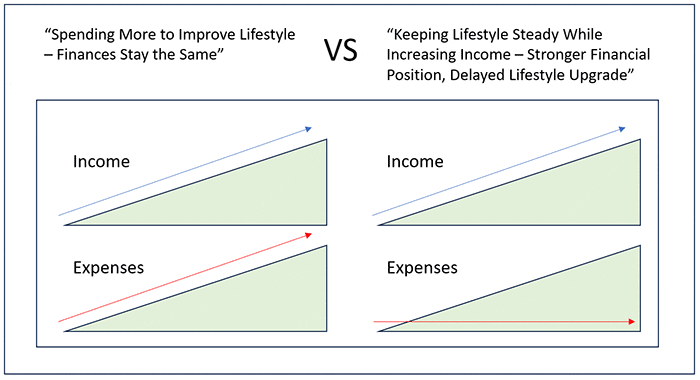What You’ll Take Away from This Story
- Why growing the gap between what you earn and what you spend (the “wedge”) matters more than chasing raises alone
- How to avoid lifestyle inflation and use extra income to build real wealth
- Simple steps to create a wedge now: cut recurring costs, set limits on upgrades, and track the gap over time
Financial freedom isn’t about how much you make—it’s about the space you create between your income and your spending.
Stop Spending Every Raise—Use the Wedge Effect to Grow Wealth
Morgan hurried into the coffee shop, fifteen minutes late and still glued to her buzzing phone. Even on a Saturday, work emails followed her around. She slid into the booth across from her friend Tara with a deep sigh.
“Sorry I’m late. The store manager called in sick, so I had to open this morning,” she said, brushing her auburn hair behind her ears. “And I have to be at my consulting gig by four.”
Tara raised an eyebrow. “That’s your third Saturday this month working both jobs. How are you holding up?”
Morgan gave a tired shrug. “Honestly? It feels like I’m spinning in place. I’m working sixty-hour weeks, pulling in more income than ever… but I’m still carrying credit card debt. I’m still scrambling to make rent some months.”
She stared into her untouched coffee. “I keep thinking, if I could just hit reset, I’d get it right the second time.”
Tara blinked in surprise. “You seem like you’ve got it all together. New apartment in Riverview, weekend getaways…”
“All on credit cards and overtime,” Morgan admitted quietly. “I’m drowning.”
Numbers Don’t Lie
Tara leaned forward. “Would you be okay if we took a look at your finances together? Maybe I can help.”
Morgan hesitated, then nodded. “At this point, I’ll try anything.”
They moved to a quieter table. Morgan opened her laptop, and together they went through her income, spending, and debts. Tara asked gentle questions while Morgan entered numbers into a spreadsheet.
After about thirty minutes, a pattern appeared. Tara created a simple chart and turned the screen toward her friend.
“Look at this,” she said, pointing to the two lines steadily rising. “The blue line is your income. You’ve done great—it’s up nearly 40% over the last few years.”
“Yeah, with promotions and the consulting side gig,” Morgan said, still staring at the chart.
“And this red line,” Tara added, “is your monthly spending. Notice anything?”
Morgan leaned in. Her eyes widened. “It’s going up at almost the same pace.”
“Exactly. Every time your income rises, your expenses rise with it. You’re stuck in a pattern—what I call the parallel trap.”
The Wedge Revelation
“But there’s a way out,” Tara said, reaching for a napkin and drawing a triangle. “I call it the Wedge Effect. The idea is simple: when your income goes up, you resist the urge to raise your spending by the same amount. Keep your expenses mostly flat, and let the gap—or wedge—grow.”
Morgan frowned. “But I worked hard for those raises. Shouldn’t I get to enjoy the benefits?”
“The wedge is the benefit,” Tara replied. “I’ve been using this method since my first promotion. My income has tripled, but my expenses have only gone up about 35%. I’m debt-free, I have a healthy emergency fund, and I invest every month.”
Morgan leaned back, absorbing it. “Meanwhile, I’m working nonstop just to support my lifestyle.”
Small Changes, Big Impact
“Don’t beat yourself up,” Tara said. “Most people fall into this without realizing it. The good news? You can start now.”
Morgan nodded. “Okay, but I can’t just break my lease or cancel everything overnight.”
“You don’t have to. The first step is to stop letting expenses grow in parallel. We’ll trim what we can now, and when your next raise comes, you lock in the wedge.”
They spent the next hour reviewing Morgan’s spending. Together, they found nearly $600 a month in costs she could cut without making her miserable—unused subscriptions, a gym membership she forgot about, and eating out five nights a week.
The Transformation
Six months later, Morgan walked into the same coffee shop—this time early and smiling.
“I got promoted to department manager,” she said, beaming. “Fifteen percent raise.”
“That’s amazing!” Tara said. “So, what’s the plan?”
“I’m using twenty percent of it to upgrade my apartment—closer to work, way less commuting stress. The rest? Straight into debt payments and savings.”
She opened her laptop and showed Tara the new chart. This time, the lines weren’t parallel. A visible wedge had formed.
“It’s small,” Morgan said, “but that space means freedom. I’ve already paid off one credit card. And guess what? I dropped the consulting job. I sleep better. I feel in control.”
Tara smiled. “That wedge will keep growing. The peace of mind only gets stronger.”
Morgan nodded. “I used to think freedom meant earning enough to buy what I wanted. Now I know it’s about what I don’t buy. That space between what I make and what I spend? That’s where freedom lives.”
The Lesson
Morgan’s story isn’t unique. Many people assume the solution to money stress is to earn more. But if your spending grows with your income, you’re stuck in the same place.
The real solution is the wedge—the gap you build between what you earn and what you spend. That gap is what fuels savings, pays off debt, and creates options.
Whether you earn $50K or $500K, the principle is the same.
Using This Lesson for Yourself
Here’s how to start using the Wedge Effect in your own life:
- Pause Before You Inflate Your Lifestyle
When your income rises, don’t automatically upgrade your life. Ask:
- “Do I truly need this?”
- “Will this make my life better in a lasting way?”
- Cap Lifestyle Upgrades
Reward yourself—just don’t go all in. Set a limit:
- Use only 15–20% of your raise for lifestyle upgrades
- Direct the rest toward:
- Paying off debt
- Building savings
- Investing for the future
- Start From Where You Are
Even if you’re not expecting a raise soon, you can still grow a wedge by trimming current expenses:
- Cancel things you don’t use
- Adjust habits like takeout or delivery
- Revaluate big expenses like rent, cars, or memberships
Small shifts add up overtime. You don’t need to feel deprived—just more in control.
Checklist
How well are you applying the Wedge Effect?
- I’ve reviewed my spending in the last 30–60 days
- I’ve cut or adjusted things I don’t really use
- I avoid spending raises or bonuses by default
- I redirect new income toward savings or debt
- I can see a growing gap between income and expenses
- I feel more in control of my money than last year
If you can’t check all of these yet, that’s okay. Progress beats perfection.
FAQ
Q: Does this mean I can’t enjoy future raises?
A: Not at all. It’s about balance. Enjoy some of your raise—just don’t spend all of it by default.
Q: What if I don’t get raises regularly?
A: You can still grow a wedge:
- Trim existing expenses
- Earn extra through side work
- Redirect windfalls like tax refunds or bonuses
Even an extra $50/month makes a real difference over time.
Q: How do I “see” the wedge grow?
A: Track it! Use a spreadsheet or budgeting app to chart your income and expenses. As the gap widens, you’ll see your wedge—and your progress—clearly.
Conclusion: Freedom Lives in the Space You Create
Financial freedom doesn’t come from hitting some magic salary. It comes from mastering the gap between what you earn and what you spend.
The Wedge Effect gives you a simple but powerful framework: earn more, spend less than you could, and grow the gap that fuels your freedom.
Start small. Review your spending. Plan for your next raise. Track your wedge.
One change at a time, you’ll build the space where confidence, control, and freedom live.


